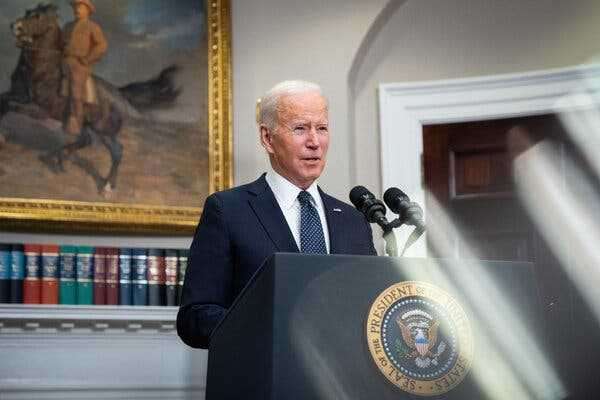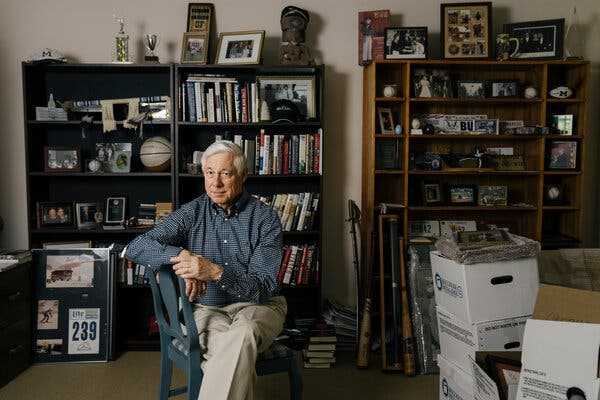President Biden made three critical decisions about how to handle Russia’s provocations, aiming to prevent armed conflict in Ukraine.

“Russia has a choice between war and all the suffering it will bring or diplomacy that will make a future safer for everyone,” the president said in a speech last week.
WASHINGTON — In a series of top-secret meetings last October, President Biden’s national security team presented grim intelligence that would soon trigger a fierce effort to prevent what could become the largest armed conflict in Europe since World War II.
Vladimir V. Putin, the Russian president, was preparing to invade Ukraine, top intelligence and military officials told Mr. Biden. Gathering each morning in the Oval Office for the global threat assessment known as the President’s Daily Brief, they described satellite images of Russian forces methodically advancing toward Ukraine’s border.
Not only did the United States have images of troops moving into position, it also had the Russian military’s plans for a campaign against Ukraine — elements of which had already begun. At one of the morning meetings, Mr. Biden dispatched William J. Burns, the C.I.A. director, to Moscow with a message for Mr. Putin:
We know what you’re planning to do.
Stopping him would be a challenge. Many of America’s closest allies were skeptical that Mr. Putin — a master of disinformation — would actually invade. The use of U.S. military force against Russia was off the table, so the allies would have to threaten Mr. Putin with economic pain so severe it would also have consequences in Europe and the United States. And it was far from certain that Republicans in Congress would back whatever the administration did.
On Monday, after delivering a grievance-filled speech attacking Ukraine’s sovereignty, Mr. Putin ordered troops into two Russia-backed separatist regions in the country. But it remains unclear how far, or quickly, the Russian military will advance. And by day’s end, the United States and its allies imposed only limited sanctions, reserving the full might of their response for moves that Mr. Putin might yet make.
The White House acknowledged from the start that its campaign to stop Mr. Putin might not actually prevent Russia from invading Ukraine. But at the very least, White House officials say, Mr. Biden exposed Mr. Putin and his true intentions, which helped unite, at least for now, the at-times fractious NATO alliance.
Over the course of three and a half months, Mr. Biden made three critical decisions about how to handle Russia’s provocations, according to interviews with more than a dozen senior administration officials and others who requested anonymity to discuss confidential meetings. Early on, the president approved a recommendation to share intelligence far more broadly with allies than was typical, officials said. The idea was to avoid disagreements about tough economic sanctions by ensuring that everyone knew what the United States knew about Mr. Putin’s actions.
Mr. Biden also gave the green light for an unprecedented public information campaign against Mr. Putin. With the support of his top intelligence officials — and with a promise to protect the intelligence agencies’ “sources and methods” — the president allowed a wave of public releases aimed at preventing Mr. Putin from employing his usual denials to divide his adversaries.
ImageA delivery of military equipment including Javelin missiles from the United States arriving last month outside of Kyiv, Ukraine’s capital.Credit…Brendan Hoffman for The New York Times
And when it became clear this year that Mr. Putin was continuing to build up forces at Ukraine’s border, the president approved sending Ukraine more weapons, including Javelin anti-tank missiles, and deploying more troops to other countries in Eastern Europe as a show of solidarity with Ukraine and to reassure nervous allies on NATO’s eastern flank.
On Sunday morning, nearly four months after those meetings, Mr. Biden once again gathered his national security team.
They had been right about Mr. Putin’s intentions. And they had managed to secure unity among allies and even Republicans behind sanctions. But all along, the decision about whether to go to war was Mr. Putin’s alone. Despite all of the efforts, it looked like war was inevitable.
At the meeting on Sunday, the discussion shifted to new questions: whether to send more troops to NATO countries; how to support a Ukrainian resistance when Russia invades; how to deal with a flood of refugees; and how to manage the economic consequences of sanctions in Europe and the United States.
“The risk for the United States is that the allies don’t stay together,” said Jeremy Bash, a former chief of staff at the C.I.A. and the Defense Department under President Barack Obama. “This crisis and this mode of a standoff with Russia is going to be around for months and years, not days and weeks.”
Understand Russia’s Relationship With the West
The tension between the regions is growing and Russian President Vladimir Putin is increasingly willing to take geopolitical risks and assert his demands.
- Competing for Influence: For months, the threat of confrontation has been growing in a stretch of Europe from the Baltic Sea to the Black Sea.
- Threat of Invasion: As the Russian military builds its presence near Ukraine, Western nations are seeking to avert a worsening of the situation.
- Energy Politics: Europe is a huge customer of Russia’s fossil fuels. The rising tensions in Ukraine are driving fears of a midwinter cutoff.
- Migrant Crisis: As people gathered on the eastern border of the European Union, Russia’s uneasy alliance with Belarus triggered additional friction.
- Militarizing Society: With a “youth army” and initiatives promoting patriotism, the Russian government is pushing the idea that a fight might be coming.
Wooing Allies
Meetings with the leaders of America’s closest allies began days after the secret October briefings, during Mr. Biden’s trip to Rome for a meeting of the leaders of the Group of 20 nations. There, he convened the biggest NATO members known as “the quint”: the United States, Britain, France, Germany and Italy.
The president and his counterparts began to sketch out the response to Russia’s aggression that day in Rome. But soon, Mr. Biden’s plan to widen the circle of trust on Ukraine was put in place, officials said.
In a series of secure video meetings from the White House, the president and his national security team started sharing highly classified information with a larger group, including Poland, Romania, and the presidents of the European Union and Canada, as well as the top officials at NATO.
Not everyone was convinced.
On Nov. 17, Avril D. Haines, the director of national intelligence, traveled to NATO headquarters for a key presentation. Although the United States has sometimes balked at sharing its best intelligence with the entire NATO alliance, worried about Russian moles in various governments, in this case the United States had already delivered a broad warning to Russia about what it knew. The briefing marked a significant shift in the allied view, officials said.
European and American intelligence officials said that Mr. Putin initially believed Europe and the United States would remain divided and unwilling to impose strong sanctions, particularly in the defense of Ukraine. He thought that he could build up a significant force and then either attack Ukraine or extract concessions from Kyiv, without much unified opposition from Europe, the officials said.
ImagePresident Vladimir V. Putin of Russia in St. Petersburg last month.Credit…Alexander Demianchuk/TASS, via Getty Images
“According to our assessment, at the end of summer, Putin likely gave instructions to prepare for military options against Ukraine,” said Mikk Marran, the director general of the Estonian Foreign Intelligence Service. “And in autumn 2021, we detected the attitude of President Putin: He felt the West was weak and the issue of Ukraine needed to be fixed.”
In fact, the alliance had its shaky moments. Four years of President Donald J. Trump’s raging against NATO had taken its toll. And Mr. Biden had angered some key European allies by what they described as a failure to consult with them about the details of the U.S. withdrawal from Afghanistan. A spat with France over a nuclear submarine deal did not help.
But Mr. Putin’s assessment ended up being a miscalculation, according to American and European officials. As the United States shared more intelligence both with NATO and individual allies, the positions hardened against Russia. The Eastern European intelligence official said that Mr. Putin’s timetable for an attack might well have been pushed back in the face of the unexpected cohesion among the allies.
“I have been in constant contact with our allies in Europe, with Ukrainians,” Mr. Biden told reporters in early December.
He said that he was putting together what he believed would be “the most comprehensive and meaningful set of initiatives to make it very, very difficult for Mr. Putin to go ahead and do what people are worried he may do.
“But that’s in play right now,” he added.
Going Public
By late November, Mr. Biden knew it was time to talk with Mr. Putin again. The Russian force was still growing and the threat of war loomed.
But the president and his aides were worried that the Russian president would use a conversation as another opportunity to manipulate public sentiment by lying about the reality playing out in the frigid areas along the Ukrainian border.
As he prepared for the call with Mr. Putin, Mr. Biden approved the public release of an unclassified intelligence document showing the positioning of what officials said at the time could eventually grow to be a huge force along the border, including heavy armor, artillery and other equipment.
“Our theory has been that putting true information into the public domain, which was bearing out in real time because everybody can see what they’re actually doing, was the best way to prevent the Russians and what they always do, which is to try to control the narrative with disinformation,” a senior administration official recalled recently.
The idea was a risky one. Weaponizing information about Russian plans could make the administration look like it was stoking war rather than trying to prevent one.
ImageA Ukrainian Army front-line position in Krymske, Ukraine.Credit…Tyler Hicks/The New York Times
In the past, intelligence agencies had blocked American proposals to release information, which some policymakers thought of as an overly cautious blanket rejection. But in this case, Mr. Burns, a career diplomat, supported a targeted strategy to declassify and release information, if the sources and methods could be protected. Ms. Haines also backed the strategy.
The Dec. 3 document became the first of a series of efforts to declassify intelligence about Russian plans by the United States and Britain, which would come to include details of a Russian sabotage campaign, a coup plot, an elaborate effort to use a faked video to create a pretext for invasion and other false flag operations plotted by Russia’s military intelligence agency, the G.R.U.
Mr. Biden and Mr. Putin spoke by secure video link for an hour and 59 minutes on the morning of Dec. 7, just three days after the declassified document went public. According to American officials, the president offered Mr. Putin a choice: agree to diplomacy or risk severe economic and political consequences from the sanctions that would be imposed after an invasion of Ukraine.
In some ways, Mr. Biden was distinctly prepared for the moment. Having visited Ukraine a half-dozen times over the last decade, he knows the country better than any other American president. His foreign policy team is made up of what are often called “Atlanticists,” who have spent their lives thinking about European security. (Antony J. Blinken, the secretary of state, grew up in Paris.)
Aides also said Mr. Biden’s long history with Mr. Putin made him less susceptible to the Russian president’s tactics. In conversations about Ukraine, officials said that Mr. Putin often liked to expound for long periods of time on minute details of the Minsk agreement, a complicated years-old effort at diplomacy with Ukraine, hoping to confuse the situation.
Mobilizing Troops
On Christmas Day last year, the Russian military publicly announced the withdrawal of 10,000 troops from Ukraine’s border, calling it proof that Mr. Putin had no intentions of invading his neighbor any time soon.
Inside the White House, the president and his team were not buying it.
Intelligence officials had seen repeated instances in which the Russians would move a battalion tactical group close to the border, set up the infrastructure necessary for a rapid invasion, and then move the troops back out, leaving a shell that could be used by other battalions, the Russian National Guard or other military forces loyal to Mr. Putin.
The movement of troops back and forth was not evidence of a retreat, officials said. It was evidence of the opposite: preparations for an invasion of Ukraine.
But Mr. Biden had agreed to send Mr. Blinken and others for a week of intense diplomacy in Europe the week of Jan. 10. Those talks culminated in discussions in Vienna on Thursday, Jan. 13, with the goal of convincing Mr. Putin not to risk crippling sanctions by sending his forces into Ukraine.
The next day, tens of thousands of Russian troops started pouring into Belarus, Ukraine’s northern neighbor, for what Russia called joint military exercises.
ImageA satellite image from earlier this month showing battle groups and artillery deployments in Belarus.Credit…Maxar Technologies., via Agence France-Presse — Getty Images
On Jan. 18, the administration ratcheted up their public information campaign with a State Department briefing for reporters on Belarus, revealing the extent of the Russian activity there.
The next day, hours before Mr. Biden held a two-hour news conference in the East Room of the White House, he met virtually from the Situation Room with a half dozen senators — Democrats and Republicans — who had just returned from Ukraine. Unlike his many clashes with Republicans over domestic policy, Mr. Biden had secured largely bipartisan support.
The news conference did not go well. In response to questions, Mr. Biden suggested the allies might not respond to what he called a “minor incursion” by Russia. His team spent the later part of the day quickly reassuring President Volodymyr Zelensky, the president of Ukraine, and allies that any incursion — no matter how small — would trigger punishing sanctions.
For months, Defense Secretary Lloyd J. Austin III had convened twice weekly meetings with top civilian and military leaders to hone the military’s options. The meetings, called “Op/Policy Sync” sessions, focused in part on one of Mr. Austin’s three “north stars” or guiding strategic principles: avoiding a direct confrontation in or near Ukraine between Russia and the United States, the world’s two largest nuclear powers.
By the end of January, however, both Mr. Austin, a retired four-star Army general known for his cautious judgments, and Gen. Mark A. Milley, the chairman of the Joint Chiefs of Staff, a military historian who carries with him a map of Ukraine marked with tactical details, no longer saw any possible ambiguity in what more than 100,000 Russian forces intended to do. These weren’t just training exercises, as the Russians insisted.
ImageAmerican soldiers deploying to Europe from Fort Bragg, N.C., are expected to train with Polish forces at several locations around the country.Credit…Kenny Holston for The New York Times
“Mr. President, we’ve entered a period of unambiguous warning,” Mr. Austin told Mr. Biden, according to a senior Pentagon official. “Putin is putting his troops in position to attack, and it’s now time to be in position to respond rapidly.”
In a meeting on Jan. 22 at Camp David, the presidential retreat in Maryland, senior Pentagon officials presented Mr. Biden with several options that would shift American military assets much closer to Mr. Putin’s doorstep, administration officials said.
The options included sending 1,000 to 5,000 troops to Eastern European countries, with the potential to increase that number tenfold if things deteriorated, officials said.
A week later, on Feb. 2, the Pentagon announced the first group of nearly 5,000 paratroopers from the 82nd Airborne Division at Fort Bragg, N.C., would deploy to Poland to reassure a pivotal ally on NATO’s eastern flank.
The Endgame
For months, Mr. Biden had tried to avoid a war in Europe. But now, with Russian forces on the move, the president and his aides have new challenges.
After Mr. Biden and his top aides predicted for weeks that Mr. Putin would likely launch an all-out assault on Ukraine, a more limited Russian incursion could undercut the resolve of the alliance that Mr. Biden has assembled.
Ben Rhodes, who served as a deputy national security adviser in the Obama administration, said Mr. Putin might not immediately advance into the rest of Ukraine, avoiding the scenes of mass refugees and major battles that officials had predicted.
“It’s easier to get leaders to do things that are hard if the more dramatic consequences are evident to everybody,” he said. “You could be in a strange window of time when there’s disagreement.”
A slow-moving invasion, in which Mr. Putin’s forces remain in the disputed, separatist-held areas for weeks or months, could also strain the bipartisan support that had coalesced around Mr. Biden’s tough approach in the months leading up to Monday’s actions by the Russian leader.
Some Republicans lashed out immediately, urging the president to move more quickly to impose sanctions. Senator Lindsey Graham, Republican of South Carolina, wrote on Twitter that Putin’s moves on Monday amounted to “a declaration of war against the people of Ukraine.”
He added: “His decision should immediately be met with forceful sanctions to destroy the ruble and crush the Russian oil and gas sector.”
And now that it appears that the Russian president is ignoring those threats, Mr. Biden risks being accused by Republicans and other critics of having failed to do enough to prevent an invasion in the first place. Mr. Rhodes said that criticism would be unfair.
“Sanctions can impose a cost and make things more difficult for Putin,” Mr. Rhodes said. “But they can’t shake his calculus entirely.”
Source: nytimes.com



